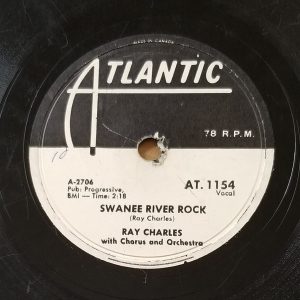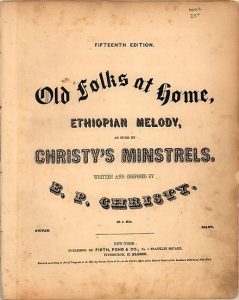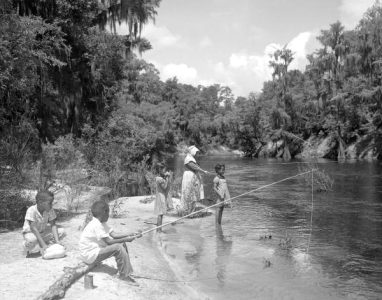#6: Swanee River Rock by Ray Charles
City: Dauphin, MB
Radio Station: CKDM
Peak Month: December 1957
Peak Position in Dauphin ~ #6
Peak Position in Vancouver ~ did not chart
Peak Position on Billboard Hot 100 ~ did not chart
YouTube: “Swanee River Rock”
Lyrics: “Swanee River Rock”
Ray Charles Robinson Sr. was born in 1930 in Albany, Georgia. His half-brother, George, was born when Ray was one-years-old. The brother had the same father, but George’s mother was someone the father had taken up with after he abandoned the family in the first year of Ray Charles’ life. George died accidentally in their mother’s laundry tub at the age of 4. From an early age Ray learned to play piano, though he began to lose his sight at the age of 4, and lost it by age 7. In 1937, Ray Charles was sent to St. Augustine (FL) to attend the Florida School for the Deaf and the Blind. At the school, young Ray learned to play classical piano by using braille music. In 1945, his mother died when he was 14-years-old.
Charles began to play piano for bands at the Ritz Theatre an the Afro-American neighborhood in Jacksonville called LaVilla. He made $4 a night (about $68 in 2024 dollars). For some years he lived on the edge of poverty and starvation. In 1949, living in Seattle, Ray Charles was part of the McSon Trio. Their recording of “Confession Blues” reached #2 in some regional R&B markets. Subsequently, he formed the Ray Charles Trio, and in 1951 “Baby Let Me Hold Your Hand” reached the Top 5 on the national R&B charts.
In 1953, Charles switched record labels and signed with Atlantic. He had a #3 R&B hit with “Mess Around”, a #5 hit with “It Should’ve Been Me”, and a Top Ten hit with “Don’t You Know”. But it was his recording in late ’54, “I’ve Got A Woman”, which was a break-out hit that reached #1 on the R&B charts in May 1955. Charles repeated the feat with “A Fool For You”, which peaked at #1 in August 1955. His non-consecutive string of number-one hits continued with “Drown In My Own Tears” in March-April 1956.
Ray Charles twelfth Top Ten hit on the R&B charts in the USA was “Hallelujah I Love Her So“. In 1957, a jazz album titled The Great Ray Charles was released. His single, “Ain’t That Love” reached #3 on CKEY in Toronto in early ’57. As well, his debut album – Ray Charles – consisted of 14 tracks, eleven of which had been Top Ten hits between 1953 and 1957. In December 1957, “Swanee River Rock” was a Top Ten R&B hit and also popular on numbers of AM-Top 40 radio.

Ray Charles wrote “Swanee River Rock”. The single later appeared on the 1958 studio album Yes Indeed!! “Swanee River Rock” is an uptempo R&b treatment of the Stephen Foster song “Old Folks at Home”. However, Foster isn’t listed in the song’s credits on “Swanee River Rock”. When Foster wrote the song in 1851, Edwin Pearce “E.P.” Christy, commissioned it for use in his blackface minstrel troupe, Christy’s Minstrels. Christy also asked to be credited as the song’s creator, and was so credited on early printings. As a result, while the song was a success, Foster did not directly profit much from it, though he continued to receive royalties for the song.

Foster had composed most of the lyrics but was struggling to name the river of the opening line, and asked his brother, Morrison, to suggest one. Morrison wrote, “One day in 1851, Stephen came into my office, on the bank of the Monongahela, Pittsburgh, and said to me, ‘What is a good name of two syllables for a Southern river? I want to use it in this new song of Old Folks at Home.’ I asked him how Yazoo would do. ‘Oh,’ said he, ‘that has been used before.’ I then suggested Pedee. ‘Oh, pshaw,’ he replied ‘I won’t have that.’ I then took down an atlas from the top of my desk and opened the map of the United States. We both looked over it and my finger stopped at the ‘Swanee,’ a little river in Florida emptying into the Gulf of Mexico. ‘That’s it, that’s it exactly,’ exclaimed he delighted, as he wrote the name down; and the song was finished, commencing, ‘Way Down Upon de Swanee Ribber.’ He left the office, as was his custom, abruptly, without saying another word, and I resumed my work.”
The original lyrics from 1851 are as follows:
Old Folks at Home
Way down upon de Swanee ribber,
Far, far away,
Dere’s wha my heart is turning ebber,
Dere’s wha de old folks stay.
All up and down de whole creation
Sadly I roam,
Still longing for de old plantation,
And for de old folks at home.
Chorus
All de world am sad and dreary,
Ebry where I roam;
Oh! darkeys, how my heart grows weary,
Far from de old folks at home!
2nd verse
All round de little farm I wandered
When I was young,
Den many happy days I squandered,
Many de songs I sung.
When I was playing wid my brudder
Happy was I;
Oh! take me to my kind old mudder,
Dere let me live and die.
3rd Verse
One little hut among de bushes,
One dat I love
Still sadly to my memory rushes,
No matter where I rove.
When will I see de bees a-humming
All round de comb?
When will I hear de banjo strumming,
Down in my good old home?
Lyrics by Stephen Foster
Sheet music sales for “Old Folks at Home” exceeded 20 million by 1977. This made it one of the three most commercially successful songs for sheet music sales.
Foster himself never saw the Suwannee, or even visited Florida. Foster was born in 1826, and was America’s first professional songwriter who tried to make a living writing songs. He wrote “Oh Suzanna” (1848) for his men’s social club in Cincinnati, Ohio, contained contradictory lines such as “It rain’d all night the day I left, The weather it was dry, The sun so hot I froze to death…”. It sold over a hundred thousand copies of sheet music at a time when selling five thousand was considered remarkable. He wrote “De Camptown Races” (1850) which was a song about a group of transients in a camp town who bet on horses to try to make some money. Being that betting on horses was considered immoral, the “Camptown ladies” may also have been shady. He wrote “My Old Kentucky Home” (1853) which is the official state song of Kentucky. Foster’s “Hard Times Come Again No More” (1854) is a song that asked the fortunate to consider the plight of the less fortunate. He also wrote a song for his estranged wife, Jane McDowell titled “Jeanie With the Light Brown Hair” (1854). Another iconic piece from the Romantic era is the wistful, melancholy “Old Black Joe” (1860). His last published piece was the posthumous “Beautiful Dreamer” (1864). The 1949 #2 hit song “Dear Hearts and Gentle People” (both for Dinah Shore and Bing Crosby), was inspired by a note found on Stephen Foster as he lay dying in January ‘1864.
Foster died in January 1864 at the age of 37 after getting a fever. He died penniless, having sold the clothes off his back for liquor. Foster fell in a flophouse in the Bowery district in Manhattan, got a fever and died days later.

Suwannee River near Lake City, Florida
The headwaters of the Suwannee River are in the Okefenokee Swamp in the town of Fargo, Georgia. The river runs southwestward into the Florida Panhandle, then drops in elevation through limestone layers into a rare Florida whitewater rapid. Past the rapid, the Suwanee turns west near the town of White Springs (FL), then connects to the confluences of the Alapaha River and Withlacoochee River. The confluences of these three rivers form the southern borderline of Hamilton County, Florida. The Suwanee then bends southward near the town of Ellaville, followed by Luraville, then joins together with the Santa Fe River from the east, south of the town of Branford. The river ends and drains into the Gulf of Mexico on the outskirts of the fishing village of Suwannee (pop. 300).
But nevertheless Florida made “Old Folks At Home” its state song in 1935. The official lyrics of the song in the state of Florida have replaced “plantation” with “childhood station,” and “darkeys” to “dear ones.” The 1850s English has also been modernized in the state song.
Despite the song’s popularity during the first hundred years after Stephen Foster wrote “Old Folks at Home,” few people outside of Florida actually knew where the Suwannee River was, or that it was even a real place.

Children fishing on the Suwannee River, 1957
In Ray Charles treatment of Swanee River, he echoes the first verse and the chorus. Instead of Foster’s “sad and dreary,” Charles offers that his heart is “sad and lonely.” Instead of the 1851 term “darkeys,” Ray Charles renders a line in the chorus “darling, how my heart is growing sad, so sad and lonely…” Like the original, the singer remains “far from my folks back home.”
“Old Folks at Home” (“Swanee River”) had appeared in numerous films. In 1930, Al Jolson sang the song in the musical Mammy. In 1935, Bing Crosby sang the song in the musical comedy Mississippi. In 1936, Jean Arthur sang part of the song in the film Mr. Deeds Goes to Town. The 1939 musical, Swanee River, was about Stephen Foster and E.P. Christy (played by Al Jolson) and the creation of the song “Swanee River”. In 1940, the song was featured in the Christmas romance with Barbara Stanwyck and Fred McMurray, Remember the Night. In 1941, the song appeared in both Babes on Broadway and Nice Girl? It was featured in The Palm Beach Story (1942), Ghost Catchers (1944), and Road to Rio (1947). In 1982, an instrumental version of “Swanee River” was played in Grease 2. And in 2010, an a cappella version of the song appeared in The King’s Speech.
In 1957, Ray Charles’ “Swanee River Rock” peaked at #2 in Albany (NY) and Bethesda (MD), #4 in New Orleans and Seattle, #6 in Dauphin (MB) and Amherst (MA), and #8 in Minneapolis/St. Paul.
In 1958, Ray Charles appeared at the Newport Jazz Festival and recorded his first live album from his performance. He also performed at Carnegie Hall, and at the Shrine Auditorium in Los Angeles. The latter as one of the headliners alongside Sam Cooke, Little Willie John, and Ernie Freeman.
Charles was back in the Top Ten on the R&B charts in 1959 with “Night Time Is The Right Time”. But it was “What’d I Say” that became his first crossover hit to crack the Top 50 on the Billboard Hot 100. It reached #1 on the Hot R&B Sides chart and #6 on the Hot 100. In Canada, “What’d I Say” cracked the Top Ten in Calgary (#6) and Cornwall, Ontario (#7). From this point on, most of his single releases were crossover R&B to pop hits.
In November 1959, Charles signed with ABC-Paramount and had his first number-one hit on the Billboard Hot 100 with “Georgia On My Mind”. The single peaked at #3 on the Hot R&B Sides chart and #24 in the UK. “Georgia On My Mind” won Grammy Awards for Best Performance by a Pop Single Artist, and Best Vocal Performance Single Record or Track, Male Vocalist, and got a nomination for Record of the Year. While The Genius of Ray Charles won him a Grammy Award for Best Vocal Performance Album, Male. As well, Charles also won a Grammy for “Let The Good Times Roll” in the Best Rhythm & Blues Performance category.
In 1961, Ray Charles had a #1 R&B hit with “One Mint Julep”, and a #1 hit on both the pop and R&B charts with “Hit The Road Jack”. In Canada, it was only in Vancouver where the song topped that pop charts. “Hit The Road Jack” won Charles a Grammy Award for Best Rhythm & Blues Recording. A third Top Ten pop hit and third #1 R&B hit in ’61 for Ray Charles was “Unchain My Heart”. While in 1960, The Genius Hits the Road became his first Top Ten studio album on the Billboard Top LPs chart. While Genius + Soul = Jazz reached #4 on the Top LPs chart in 1961. The latter received a Grammy Award nomination for Album of the Year.
During this time his albums, Modern Sounds in Country and Western Music, Modern Sounds in Country and Western Music Volume Two, and Ingredients in a Recipe for Soul were released. These albums were big sellers on the album charts. The first of these topped the Billboard Top LPs chart, and reached #6 in the UK. It also earned a Grammy Award nomination for Album of the Year. The second reached #2 in the USA and #15 in the UK. While Ingredients in a Recipe for Soul peaked at #2 on the Top LPs chart
His chart-topping ways continued in 1962 with “I Can’t Stop Loving You”. The single reached number-one in Australia, Sweden, the UK and USA, and #4 in Norway. Though Canada didn’t have a national pop chart at the time, “I Can’t Stop Loving You” peaked at #1 in Montreal, Ottawa, and Toronto. (It stalled in Vancouver at #41). At the Grammy Awards, Ray Charles received three nominations for “I Can’t Stop Loving You”, winning in the Best Rhythm & Blues Recording category.
Ray Charles also had Top Ten hits in ’62 with “You Are My Sunshine” and “You Don’t Know Me”. While in 1963, he was back in the Top Ten with “Take These Chains From My Heart” and “Busted”. The latter got two Grammy nominations, and Charles won in the Best Rhythm & Blues Recording category.
During the British Invasion, Ray Charles struggled to find commercial success. He had a couple of Top Ten hits on the Hot R&B Sides chart in ’64, but waited until 1966 when “Crying Time” cracked the Top Ten. For his effort, he won a Grammy Awards for Best R&B Solo Performance, and for Best R&B Recording. And though “Let’s Go Get Stoned” stalled at #50 on the Billboard Hot 100, it climbed to #1 on the R&B charts in ’66.
In 1967, “Here We Go Again” reached #15 on the Hot 100, and #5 on the R&B charts. He would release over two dozen more singles into the 70s. But few of these cracked the Top 40, with his cover of the Beatles’ “Yesterday” reaching #25 in 1967. For this recording, Ray Charles received three Grammy Award nominations.
In April 1979, “Georgia On My Mind” became the official song for the state of Georgia. He performed the song before the state lawmakers in March ’79.
In the 1980s, on the Columbia label, Ray Charles had several Top Ten hits on the Country & Western charts. “Seven Spanish Angels” peaked at #1 in 1985 in a duet with Willie Nelson. In 1990, with Quincy Jones and Chaka Khan, a cover of the Brothers Johnson’s “I’ll Be Good to You” peaked at #1 on the Hot Black Singles and Hot Dance Club Play charts. The single earned the trio a Grammy Award in the Best R&B Performance by a Duo or Group with Vocal.
Over the years, Ray Charles received 37 Grammy nominations and won 17 awards.
In 2004, Ray Charles died at the age of 73 due to liver failure. At the 47th Grammy Awards in February 2005, Ray Charles there was a Tribute to Ray Charles. The winner for Record of the Year and also Best Pop Collaboration with Vocals were Ray Charles & Norah Jones for their duet “Here We Go Again”. Charles also posthumously won Album of the Year and Best Pop Vocal Album for Genius Loves Company. On the album, Ray Charles sang duets with a variety of recording stars. These included Gladys Knight, Johnny Mathis, Elton John, James Taylor, Van Morrison, B.B. King, Diana Krall, Nathalie Cole, Michael MacDonald, and Bonnie Raitt. Genius Loves Company topped the pop album charts in Austria, Canada, Italy and the USA.
July 13, 2024
Ray McGinnis
References:
Jon Pareles and Bernard Weinraub, “Ray Charles: Bluesy Essence of Soul, is Dead at 73,” New York Times, June 11, 2004.
Gail Mitchell, “Ray Charles innovated in business as well as music,” Reuters, September 17, 2010.
Van Morrison, “Ray Charles: #10 – 100 Greatest Artists,” Rolling Stone, April 20, 2011.
“Ray Charles Chart History,” Billboard (pop charts), February 1990.
Rebecca Burns, “32 Years Ago This Month: Ray Charles Serenades the Legislature,” Atlanta magazine, March 7, 1979.
Michael Friedman, “Can’t Escape Stephen Foster,” New Yorker, March 10, 2014.
Laura Kleindienst, “Senate cleans up lyrics of state song,” Sun-Sentinel, Palm Beach, FL, April 25, 2008.

CKDM 730-AM Dauphin (MB) Top Ten | December 21, 1957

Leave a Reply